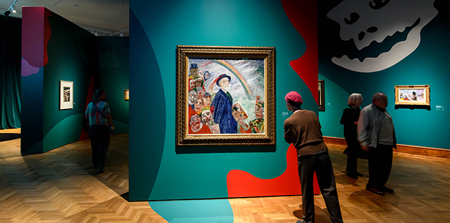

In Your Wildest Dreams, Ensor Beyond Impressionism
Tinker imagineers
In Your Wildest Dreams, Ensor Beyond Impressionism Immersive, interactive scenography reimagines the exhibition “Impressive attempt at instilling new and interactive materials to showcasing what is typically a static artwork exhibition.”, Azlan Nazam, WIN Awards Judge
Commissioned as the culmination of Belgium’s Year of Ensor, the Royal Museum of Fine Arts Antwerp (KMSKA) partnered with Tinker imagineers to reframe James Ensor’s legacy for contemporary audiences. The ambition was clear: turn a temporary wing of more than 1,000 sq m into an immersive, intelligible journey that would resonate with both connoisseurs and first‑time visitors. Thirteen themed rooms mapped the artist’s evolving ideas and psychology, while a dramatic entry arch in the form of Ensor’s head signalled the invitation to step directly into his world.
Innovation sat at the heart of the experience. The team orchestrated a theatrical language of layered light, shadow, and texture, balanced by sumptuous drapery and emphatic contrasts to mirror Ensor’s own tensions between satire and sincerity, realism and fantasy. Digital and analogue interventions worked in concert: touchscreen easels revealed hidden details; a Pepper’s Ghost apparition resurrected the artist in his studio; shadow‑play animations and a carnival mask photo moment encouraged exploration without diluting curatorial depth. Technology and AV were integrated discreetly to preserve atmosphere and focus on the works.
Sustainability and practicality were embedded from the outset. Existing museum hardware was reused wherever feasible; additional components were rented or designed for long‑term reuse. A largely modular, off‑site build accelerated installation, simplified deconstruction, and reduced waste and cost. Material choices were assessed for environmental performance, while lighting and media were engineered to be efficient, adaptable, and unobtrusive. Accessibility considerations shaped circulation, interactives, and interpretive clarity, ensuring the exhibition remained open and comprehensible to a broad audience.
The results were emphatic: more than 282,000 visitors in under six months and widespread critical acclaim. Beyond attendance, the project reframed what a collection‑led exhibition can be—academically rigorous yet emotionally immediate—by drawing people into Ensor’s imagination rather than merely presenting it. Judges noted the strong alignment of spatial and visual design with the curatorial narrative, praising the inventive use of multimedia, nuanced light‑and‑shadow, and varied scale to keep the experience engaging from room to room. It stands as a compelling benchmark for museums and galleries seeking deeper public engagement.
The judges said: “Impressive attempt at instilling new and interactive materials to showcase what is typically a static artwork exhibition.” “The use of multiple media is commendable, especially light and shadow play which is usually excluded.” “The spatial and visual design is strongly integrated with the exhibition content, and there is a relatively clear narrative conveyed throughout the space” “The whole exhibition made the judges feel crazy dreams in front of the screen.”